- 7 Top Flite Golf Clubs XL for Improved Performance - September 28, 2024
- Top Flite Golf Clubs: Top 5 Reasons to Choose Them - September 28, 2024
- Top 3 Golf Club Fitters for a Perfect Swing - September 28, 2024
You're looking to improve your golf game, and understanding golf club offset technology is a great place to start. Offset clubheads position the face slightly back from the hosel, helping you square the face at impact for better accuracy. This design particularly benefits golfers struggling with slicing, promoting straighter shots and more consistent ball flight. By understanding how offset technology works and its benefits, you'll be able to make informed club selections that cater to your swing style, ultimately leading to longer, straighter shots and improved overall performance – and there's more to explore on how to get the most out of it.
Key Takeaways
- Offset technology positions the clubface slightly back from the hosel, aiding in squaring the face at impact for improved accuracy.
- Higher degrees of offset in drivers and longer irons assist slower swing speeds, while advanced materials and AI optimize performance, feel, and forgiveness.
- Offset clubheads allow for a more consistent swing path and better alignment at impact, contributing to straighter shots and reducing slice risk.
- Understanding offset is crucial for high handicap and beginner players, as selecting the right offset can significantly enhance overall game performance.
Understanding Offset Technology
When examining the design of golf clubs, you'll often encounter the term 'offset technology.' This fundamentally refers to the deliberate positioning of the clubface slightly back from the hosel, a clever innovation that helps you square the face at impact for improved accuracy and reduced slicing.
The amount of offset varies among manufacturers and club types, with drivers and longer irons typically featuring a higher degree of offset to assist golfers with slower swing speeds. This subtle design feature allows for more time to rotate your hands and square the clubface, resulting in straighter shots and fewer slices.
As you explore deeper into the world of offset technology, you'll discover that modern clubs utilize advanced materials and artificial intelligence to optimize performance, feel, and forgiveness. The amount of offset is carefully calibrated to promote better control and flight across the set, with progressive offset designs ensuring that longer clubs have more offset than shorter ones.
Benefits of Offset Clubheads
As you explore the benefits of offset clubheads, you'll notice that they considerably improve the clubhead position at impact, which in turn reduces the risk of slicing the ball.
By squaring the clubface more consistently, you'll experience a more controlled and precise ball flight.
This design feature is particularly valuable for golfers who struggle with slicing, as it helps you achieve straighter shots and better overall accuracy.
Improved Clubhead Position
By incorporating offset clubheads into your golf set, you can enjoy a more consistent swing path, thanks to the improved clubhead position relative to the shaft. This is because the offset design allows for better alignment at impact, resulting in straighter shots.
As a golfer, you'll appreciate how the improved clubhead position helps you achieve a more consistent swing path, which is critical for accuracy and control.
The benefits of improved clubhead position are particularly noticeable for higher handicap golfers, who often struggle with slicing. By promoting better alignment at impact, offset clubheads help reduce the risk of slicing and improve overall accuracy.
This is because the offset design enables the clubface to square up more easily, resulting in improved directional control. As a result, you can expect longer and straighter shots, which will ultimately improve your overall performance on the course.
Reduced Slice Risk
Offset clubheads markedly reduce the risk of slicing for right-handed golfers, allowing you to square the clubface at impact and achieve straighter ball flights.
The design of offset clubs enables better rotation of the clubface during the downswing, promoting a more consistent ball flight. This is particularly beneficial for high handicap golfers, as it enhances forgiveness on off-center hits.
You'll notice that offset technology is commonly found in drivers and woods, where the tendency to slice is more pronounced due to the club's longer shaft and loft characteristics.
History of Offset Design
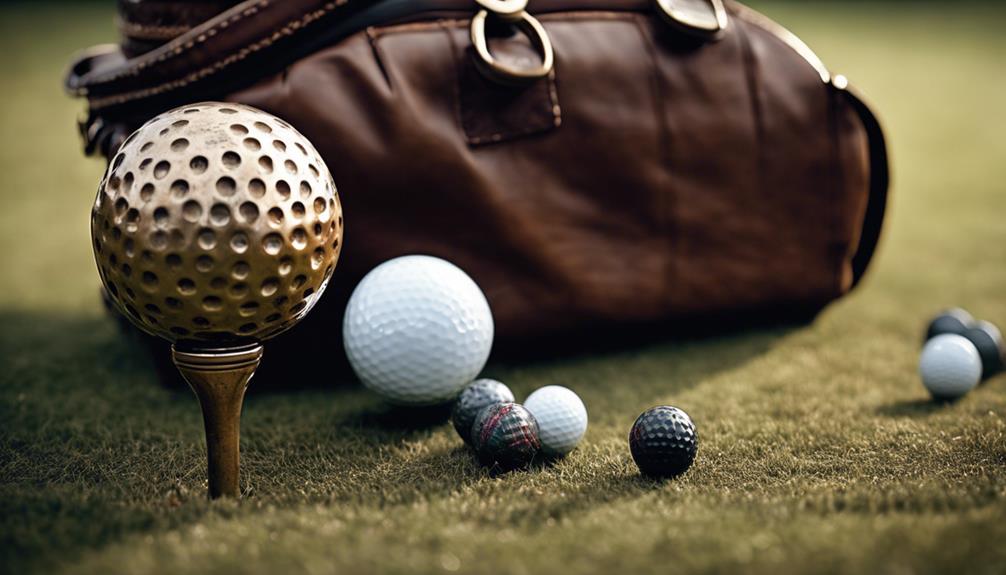
As you explore the history of offset design, you'll discover how this feature evolved over time to improve your game.
Initially, offset design emerged in putters to enhance accuracy on shorter shots, but early iron designs lacked this feature due to manufacturing limitations.
However, advancements in technology led to the widespread adoption of offset in various club types, including drivers and hybrids.
Evolution of Offset
Golf's earliest putters pioneered the concept of offset design, positioning your hands ahead of the ball to promote a smoother stroke. This innovative feature has since evolved to become a game improvement staple in modern golf clubs. The integration of offset design has expanded from putters to drivers, woods, and hybrids, catering to a wider range of golfers.
| Era | Club Type | Offset Design |
|---|---|---|
| Early | Putters | Basic offset for smoother stroke |
| Mid-20th | Irons | Limited offset due to manufacturing constraints |
| Late 20th | Drivers, Woods | Increased offset for forgiveness and accuracy |
| 21st | Hybrids, Game Improvement | Varied offset designs for specific skill levels |
| Present | Mavrik Line (Callaway) | Multiple offset styles for varied skill levels |
Today, manufacturers like Callaway have developed multiple styles of offset clubs, such as the Mavrik line, to address the needs of different skill levels. The understanding of offset's benefits has led to its widespread adoption in game improvement clubs aimed at enhancing accuracy and reducing slicing for high handicap golfers. As technology continues to advance, expect offset design to play an increasingly important role in shaping the future of golf.
Early Iron Designs
You'll notice that early iron designs lacked offset, resulting in a more traditional club appearance with the hosel and face aligned, due to manufacturing limitations that hindered innovation. At that time, club designers were restricted by the available technology, which didn't allow for the creation of offset golf clubs. As a result, iron sets had a more conventional look, with the face and hosel in alignment.
This limitation meant that golfers had to rely more on their technique to achieve accurate shots, making the game more challenging, especially for high handicappers.
However, the absence of offset in early iron designs paved the way for future innovations. As manufacturing techniques advanced, designers began to experiment with offset, which eventually led to the development of modern club designs that prioritize performance and accuracy.
The introduction of offset technology in irons has since become a game-changer, enabling golfers to achieve straighter shots and improve their overall game. Today, manufacturers offer a range of offset designs in their iron sets, catering to diverse skill levels and providing golfers with more options to enhance their performance.
Advancements in Technology
As you explore the world of golf club design, you'll notice that one notable breakthrough has been the evolution of offset technology. This technology originated in putters and has since become a standard feature in modern drivers, woods, and irons, allowing golfers to achieve greater shot accuracy.
Advancements in manufacturing have enabled clubs to be produced with varying degrees of offset, catering to different golfer skill levels and preferences. Brands like Callaway and Wilson now offer multiple styles of offset clubs, enhancing the golfing experience.
The integration of advanced technology, including artificial intelligence, has notably improved the performance and design of offset clubs, making them more accessible to average golfers.
A notable development in recent years is the concept of progressive offset, where the offset varies within a single iron set. Longer irons have more offset for improved ball flight and control, while shorter irons have less offset for greater precision.
This innovative design feature has revolutionized the way golfers approach the game, providing a more tailored experience for each individual. By understanding the advancements in offset technology, you'll be better equipped to choose the right clubs for your game and take your skills to the next level.
Role of Offset in Club Selection
When selecting golf clubs, understanding the role of offset is vital, particularly for high handicap and beginner players who struggle with slicing. Offset clubs are designed to help you square the clubface at impact, considerably reducing the risk of slicing.
To make the most of offset clubs, consider the following factors when selecting your set:
- The degree of offset varies by manufacturer and model, allowing you to choose clubs that align with your specific swing characteristics and preferences.
- Progressive offset in iron sets means that longer clubs typically have more offset, while shorter clubs feature less, promoting better control and ball flight across the set.
- Custom fitting for grip size and shaft flex, along with offset measurements, is vital for optimizing performance and ensuring the right club selection for your individual needs.
Impact of Offset on Game Improvement
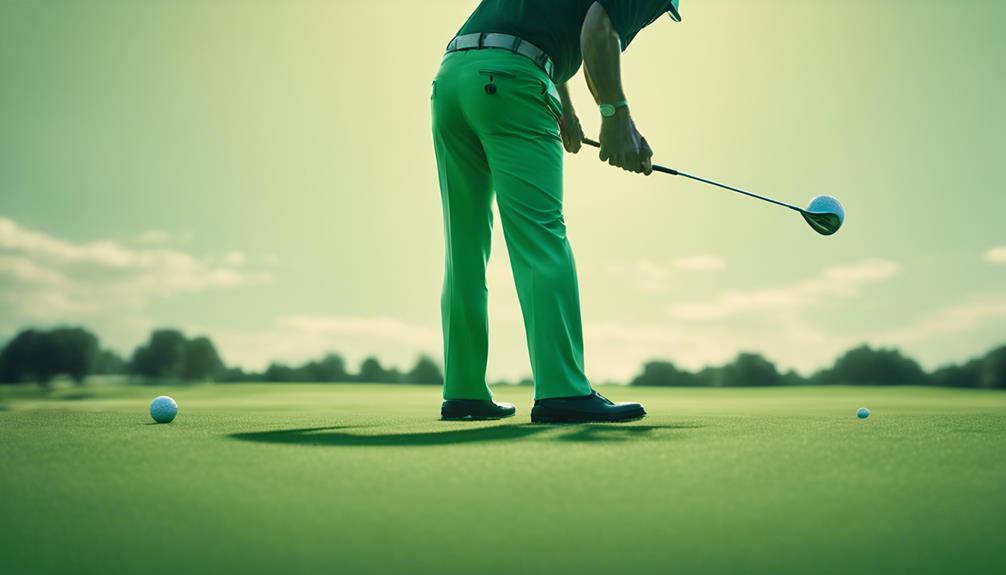
By incorporating offset clubs into your game, golfers can experience a significant reduction in slicing and a notable improvement in overall accuracy, leading to more consistent and controlled shots. This is especially beneficial for high handicap and beginner golfers, who tend to struggle with slicing.
| Benefit | Description |
|---|---|
| Improved Accuracy | Offset clubs help square the clubface at impact, reducing slicing and promoting straighter ball flight. |
| Increased Forgiveness | Offset irons feature 5mm to 8mm of offset, optimizing forgiveness on off-center hits and promoting a consistent ball flight. |
| Better Control | Progressive offset design in iron sets allows for varying degrees of offset, aiding in achieving better control and ball flight as you shift from longer to shorter irons. |
| Higher Launch Angle | Offset drivers and woods help achieve a higher launch angle, making them easier to hit for players with slower swing speeds. |
| Consistent Results | Studies show that golfers using offset clubs experience improved accuracy, resulting in more fairways hit and better greens in regulation. |
Offset in Drivers and Fairways
You'll find that offset technology is particularly effective in drivers, where it helps to counteract slicing and promote a straighter ball flight, making it an attractive option for golfers who struggle to hit fairways consistently. This is because offset in drivers helps to square the clubface at impact, a key factor in reducing slice.
Here are some key benefits of offset drivers:
- A larger clubhead design provides a more forgiving impact zone on off-center hits.
- The degree of offset can vary considerably among manufacturers, offering options for different skill levels.
- More offset can lead to improved accuracy and a higher percentage of fairways hit, especially for players with slower swing speeds.
While offset is less common in fairway woods, it can still aid in promoting a straighter ball flight when present.
As you explore offset drivers and fairways, consider how this technology can help you improve your game. By understanding how offset works in these clubs, you can make informed decisions about the right equipment for your swing.
Types of Offset Golf Clubs
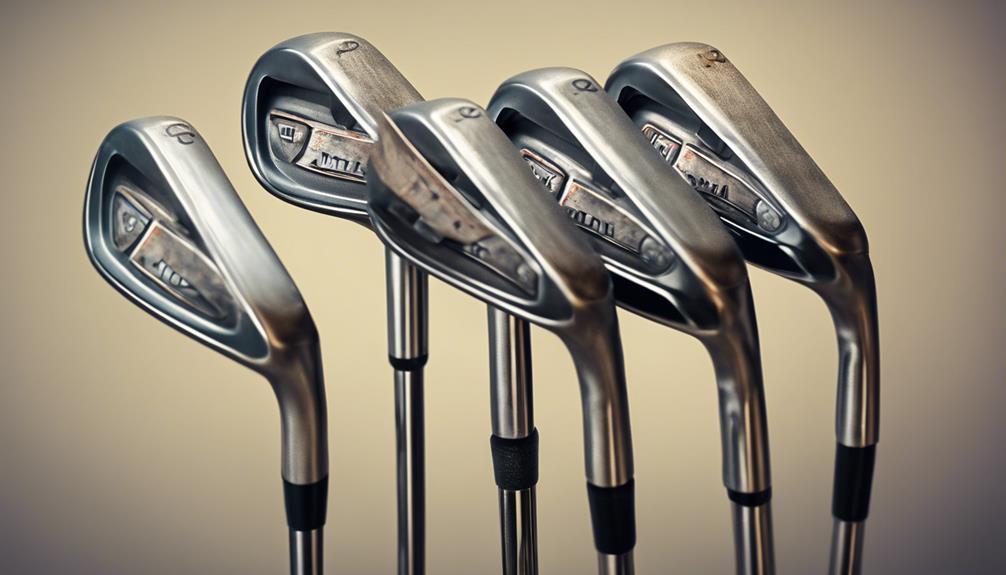
As you explore the world of offset golf clubs, you'll discover that different types of clubs incorporate offset technology in unique ways.
For instance, you'll find that offset drivers are designed to reduce slices and promote straighter shots.
Meanwhile, offset irons offer varying degrees of offset to enhance accuracy.
Now, let's take a closer look at the specific features of offset drivers, iron offset variations, and hybrid offset features that can benefit your game.
Offset Driver Design
Most golfers will benefit from understanding the nuances of offset driver design, which features a clubface set back from the hosel to help you square the face at impact and reduce slicing. This innovative design allows you to achieve a more consistent ball flight and straighter shots.
When it comes to offset drivers, you'll notice variations in the amounts of offset among manufacturers. Some offer more pronounced offset to aid higher handicap golfers, while others provide subtle offset for better players.
Here are some key features to evaluate:
- Larger clubheads provide a greater moment of inertia, enhancing forgiveness on off-center hits and promoting more consistent ball flight.
- Adjustable features allow you to customize loft and lie angles to suit your swing characteristics.
- Progressive offset design is common, where the amount of offset decreases as the club length shortens, promoting better control and shot accuracy across different clubs.
Iron Offset Variations
When selecting the right iron for your game, understanding the variations in offset design is key, as different types of offset golf clubs cater to distinct player needs and swing characteristics.
You'll find that offset irons typically feature varying degrees of offset, with high offset designs assisting high handicap players by promoting straighter shots and reducing slice tendencies. The amount of offset in irons can range from 5mm to 8mm, depending on the manufacturer and design intent, catering to different player skill levels.
Progressive offset in iron sets means that longer irons like 5-irons will have more offset compared to shorter irons like 9-irons, enhancing control and ball flight consistency. Game improvement irons generally have more offset, while players' irons tend to have less or no offset, aligning with the needs of their target audiences.
Hybrid Offset Features
Hybrid clubs, designed to bridge the gap between irons and fairway woods, incorporate offset features to enhance playability and provide a more forgiving and consistent ball flight for golfers of various skill levels.
When it comes to hybrid offset features, you'll find that these clubs are particularly effective in combating slicing issues. Here are some key benefits to take into account:
- The offset design helps square the clubface at impact, making hybrids a great option for those who struggle with slicing.
- Many hybrid models offer adjustable offset options, allowing you to customize the club to your swing style and preferences during golf club fitting.
- The progressive offset concept is also applicable to hybrids, with longer clubs typically featuring more offset to aid in achieving better launch angles and control.
Progressive Offset in Iron Sets
You'll notice that modern iron sets often feature a design element called progressive offset, where the amount of offset decreases gradually from the longest to the shortest irons. This design approach helps you, the average golfer, achieve a more consistent swing path and improved accuracy as you shift between different club lengths in your set. The offset typically decreases progressively from longer to shorter irons, allowing you to maintain the benefits of offset while promoting a more traditional feel in shorter clubs.
Manufacturers often implement progressive offset to cater to high handicap golfers and beginners, aiming to enhance forgiveness and reduce slicing throughout the entire set. By incorporating progressive offset, you'll experience better ball flight and control, especially with longer irons.
As you move to shorter irons, the reduced offset allows for a more precise and controlled swing. This design feature is a common practice in modern golf club design, with many brands offering specific measurements of offset for each iron in a set.
With progressive offset, you can take advantage of improved forgiveness and accuracy, ultimately leading to a more enjoyable and successful golfing experience.
Measuring and Converting Offset
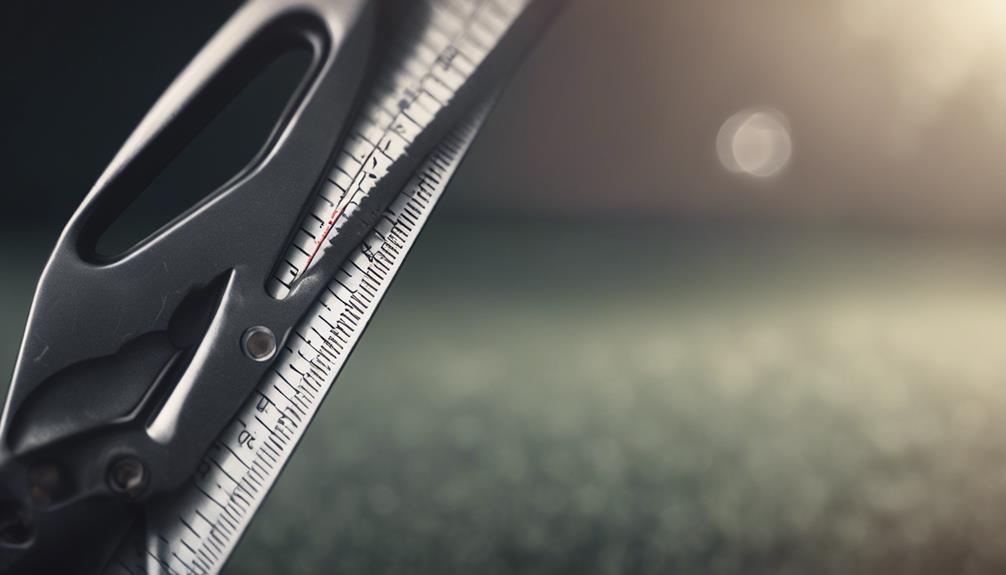
Accurate measurement and conversion of offset are essential in golf club fitting, as even slight variations can greatly impact your performance. When working with offset measurements, it's important to understand the unit of measurement being used, as values can be provided in either inches or millimeters.
Here are some key points to keep in mind:
- One inch equals 25.4 millimeters, so you'll need to convert values accordingly.
- To convert offset from inches to millimeters, multiply the value by 25.4, and to convert from millimeters to inches, divide by 25.4.
- Most golf club manufacturers provide specific offset measurements for their clubs, which can range from around 5mm to 8mm for high offset in irons.
In custom fitting, understanding offset is important in determining your preferred offset, ensuring that the club's design aligns with your swing characteristics and playing style.
Who Benefits From Offset Clubs
Offset clubs can be a game-changer for golfers who struggle with accuracy and consistency, particularly those with higher handicaps or slower swing speeds.
As a golfer, you may find that offset clubs help you achieve straighter shots and improve your overall accuracy by squaring the clubface at impact.
If you're a right-handed golfer struggling with a slice, offset clubs can be a lifesaver, reducing the tendency to slice the ball.
Slower swing speeds? Offset clubs provide additional forgiveness on off-center hits, leading to more consistent ball flight.
As you age, you may find that offset clubs help you maintain control and ease of use, allowing for higher launch angles and improved shot trajectories.
Even instructors recommend offset clubs for specific swing issues, making them a tailored solution for various skill levels.
By understanding who benefits from offset clubs, you can help you decide if they're the right fit for your game.
Whether you're a beginner or an experienced golfer, offset clubs can be a valuable addition to your bag.
Overcoming Limitations of Offset
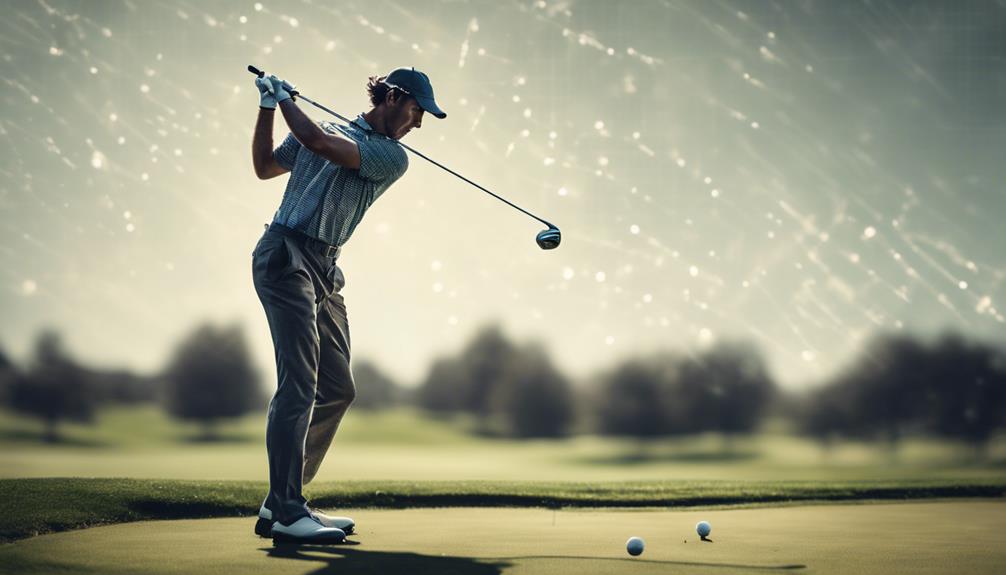
As you incorporate offset clubs into your game, it's essential to recognize their limitations and take proactive steps to avoid relying too heavily on their design.
While offset clubs can help reduce slices, they may create a reliance on the club's design rather than developing a more consistent swing technique, potentially hindering long-term improvement.
To overcome these limitations, consider the following strategies:
- Custom fitting: Find the right offset level that complements your swing style, enhancing both confidence and performance.
- Practice with both offset and non-offset clubs: Identify your preferences and develop the necessary skills to maintain control and accuracy without relying solely on offset technology.
- Focus on proper alignment and swing mechanics: Avoid compensatory errors and develop a correct swing that doesn't rely on the offset design.
Frequently Asked Questions
What Is the Offset on a Golf Club?
When you examine the club design, you'll notice the offset, which affects your swing mechanics, referring to the distance the clubface is set back from the hosel, typically measured in millimeters or inches.
What Does More Offset in an Iron Do?
As you swing, imagine a perfectly square clubface at impact. More offset in an iron helps you achieve this, reducing slicing and promoting a higher shot trajectory, resulting in better iron performance and more consistent results.
How to Hit Offset Golf Irons?
"To hit offset golf irons, you're focusing on refining your swing mechanics, ensuring a neutral grip and smooth tempo to promote a straight path. This, in turn, enhances shot accuracy, as the offset design helps square the face at impact."
How to Measure Iron Offset?
When measuring iron offset, you'll use offset measurement techniques, placing a ruler along the hosel's leading edge to calculate the distance to the face's leading edge, a critical aspect of golf club design.
Conclusion
As you tee off with an offset club, you'll be swinging with a secret weapon that can shave strokes off your game like magic!
By now, you've grasped the concept of offset technology and its benefits, from straighter shots to more forgiveness.
Remember, understanding offset is key to revealing your full golfing potential.
With the right club selection, you'll be crushing it like a pro in no time!




